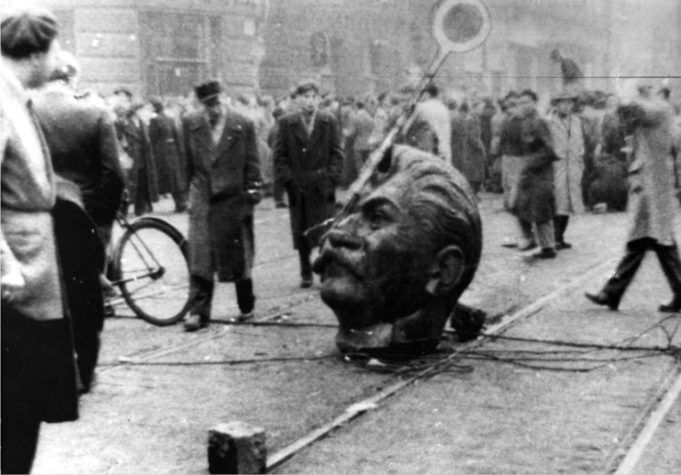By Gabor B. Racz / Wikimedia Commons / CC-BY-SA-3.0 / GFDL
1 – Hungarian Revolution of 1956
This was a nationwide revolt against the government of the Hungarian People’s Republic and its Soviet-imposed policies, lasting from 23 October until 10 November 1956.
Though leaderless when it first began, it was the first major threat to Soviet control since the USSR’s forces drove out Nazi Germany from its territory at the end of World War II.
The revolt began as a student demonstration, with thousands marching through Budapest to the Parliament building.
A student delegation entered the radio building to try to broadcast their demands but was detained.
When the delegation’s release was demanded by the demonstrators outside, they were fired upon by the State Security Police from within the building.
One student died, was wrapped in a flag, and held above the crowd. This was the start of the revolution.
As the news spread, disorder and violence erupted and spread quickly across Hungary and the government collapsed. Thousands organized into militias, battling the Police and Soviet troops.
By the end of October, fighting had almost stopped and a sense of normality began to return.
After announcing a willingness to negotiate a withdrawal of Soviet forces, the Politburo changed its mind and moved to crush the revolution.
On 4 November, a large Soviet force invaded Budapest and other regions of the country. The Hungarian resistance continued until 10 November.
Over 2,500 Hungarians and 700 Soviet troops were killed in the conflict, and 200,000 Hungarians fled as refugees. Mass arrests and denunciations continued for months thereafter.
By January 1957, the new Soviet-installed government had suppressed all public opposition. Public discussion about this revolution was suppressed in Hungary for more than 30 years.
Since the thaw of the 1980s, it has been a subject of intense study and debate.
At the inauguration of the Third Hungarian Republic in 1989, 23 October was declared a national holiday.
2 – 20,000 Women Marched in Pretoria
In one of the largest demonstrations staged in South Africa’s history, 20,000 women of all races marched to Pretoria’s Union Buildings on 9 August 1956.
The march was to present a petition against the carrying of passes by women to the prime minister, J G Strijdom.
The march against the pass laws was organized by the Federation of South African Women.
The Federation famously challenged the idea that ‘a woman’s place is in the kitchen’, declaring it instead to be ‘everywhere’.
Although Prime Minister J.G. Strijdom was not at the Union Buildings to accept the petition, the women of South Africa sent a public message that they would not be intimidated and silenced by unjust laws.
The first National Women’s Day was celebrated in 1995, and since then annual celebrations take place throughout the country.
3 – Rocky Marciano Retired Undefeated from Boxing

Rocky Marciano announced his retirement on April 27, 1956, aged 32. He finished his career at 49-0.
Marciano was an American professional boxer who held the world heavyweight title from September 23, 1952, until his retirement.
He went undefeated throughout his career and defended his title six times.
Known for his relentless fighting style, stamina, and an iron chin, Marciano has been ranked by many boxing historians as one of the best heavyweight boxers of all time.
His knockout percentage of 87.75 is one of the highest in heavyweight history.









